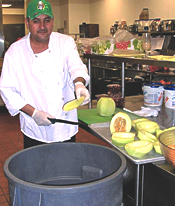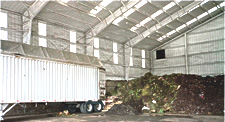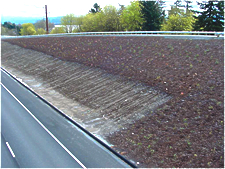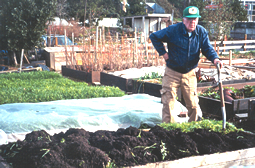 BioCycle March 2011, Vol. 52, No. 3, p. 27
BioCycle March 2011, Vol. 52, No. 3, p. 27
In the Pacific Northwest, composting is not just waste diversion. It’s the foundation of essential green infrastructure services.
David McDonald
ORGANICS recycling and reuse is becoming business as usual in regions where compost utilization has been institutionalized to provide green infrastructure services. “Green infrastructure” means using natural systems (such as soil and vegetation) to provide services that supplement or replace built system services, e.g. for storm water management, water and air quality, energy conservation, climate mitigation and adaptation, water conservation, waste recycling, and food security. The challenge for the future is not “what can we do with all this waste” but “how can we get enough compost to meet the demand for these essential services.”
What are the primary drivers to making organics recycling and reuse business as usual (BAU)? Storm water green infrastructure services from soil and vegetation are certainly the biggest regulatory-driven new demand for recycled organics. With leadership from the US EPA (under the Clean Water Act), scientists, engineers, citizens and local governments, “Low Impact Development (LID)” – managing storm water on-site – is becoming the new normal in the Pacific Northwest and other regions. LID methods rely on soil amendment with compost, thus driving demand for organics recycling and compost quality
Water conservation is another driver. One of the cheapest forms of conservation is soil amendment with compost, which can cut summer irrigation demands in half. “Save water by building your soil with compost and mulch” is the new mantra for water utilities throughout the West.
Climate is another rising driver. Composting mitigates climate change by reducing landfill methane emissions and by sequestering atmospheric carbon back into the soil where it belongs. And compost is an essential tool to adapt our urban landscapes to climate change by increasing vegetative cover – trees, green walls and roofs that filter and cool the air. That vegetative cooling also provides long-term energy savings far in excess of what could be extracted by burning organic residuals. Adding anaerobic digestion as a precomposting process can produce energy while reducing emissions and odor issues. In the face of climate uncertainty, food security is another rising concern. Local governments and citizens are recognizing that recycling organics back to the soil is the foundation of regional food security, as well as all these other essential green infrastructure services.
STEPS TOWARDS “BUSINESS AS USUAL”
In Washington State and around the Pacific Northwest we’ve come a long way toward institutionalizing organics recycling and reuse, and building market demand for organics-provided services. Here are some of the lessons we’ve learned that can be applied anywhere.

Collaboration and persistence
Recognizing your allies and building shared strategies is the starting place for market, regulatory and social transformation. For more than 20 years, the Washington Organic Recycling Council (WORC) has brought together the organics industry, regulators, local governments and scientists. That collaboration engendered shared vision and practical strategies to slowly change regulations, local policies and markets. WORC’s “Soils for Salmon” initiative expanded that network of collaboration to include builders and developers, storm water regulators and environmental activists.
Lesson learned: 1) Search out and listen to your potential allies to find out what they need, and build their ownership of a shared strategy; and 2) Be persistent – commit to the long process on many fronts that can build institutional change.
Policy changes from waste diversion to resource recovery – citizen action works
Local and state government policies that prioritize resource recovery are essential to move from short-term waste diversion decisions to the long-term economic benefits of organics-based green infrastructure services. Policy makers, legislators and regulators often want to do the right thing, but they need support and encouragement from citizens to stand up and do it. In Seattle, the voters’ 1987 decision to reject incineration and commit to recycling and composting set that policy direction. Recycling success led to citizen support for eventually banning recyclables from garbage collection, and our current path to universal residential and commercial food-and-yard organics collection. These policies provide the assurance that organics businesses and their bankers need to make long-term investments in building capacity.
Lesson learned: Don’t just talk about waste diversion economics – communicate the value of recycled and reused resources in clear terms that citizens can take to their governments to create policy change.

Solid research, and connecting science to practice through professional education
Good policies and regulations are informed and supported by solid science. In Washington, our state universities became interested early in resource recovery benefits, especially the multiple benefits (water, storm water, nutrient management) from amending soils with compost. Scientists at the University of Washington and Washington State University (WSU) helped build the technical base for both agricultural and urban organics reuse. WSU collaborated in creating WORC’s Compost Facility Operator Training that builds compost quality and business success. The Washington State Department of Transportation (WsDOT) and local governments supported field trials to prove the storm water and water conservation benefits of compost use.
The Washington Department of Ecology (DOE) and the state’s Puget Sound Partnership provided grants to help start professional education and outreach. Today, landscape architects, architects, engineers, landscapers, farmers, builders, composters and regulators have a variety of training opportunities annually in soil and composting best practices for storm water management, water conservation, construction site erosion control, odor and contaminant management and green building design. Their own professional organizations often organize the training (with a little help from WORC members). That is building a shared “soil and organics literacy” among these professions that moves us collectively from a waste-diversion mindset towards resource recovery for essential services.

Lesson learned: Share everything from science to practical lessons to training materials, so that anyone can teach a class or adapt the ideas to their profession.
Regulations driven by a vision: healthy soil for multiple benefits
The 1972 federal Clean Water Act continues to reverberate through state and local regulatory practices, especially through the NPDES (National Pollutant Discharge Elimination System) permit requirements on all storm water discharges from large cities and counties (Phase One) and now on smaller municipalities under 100,000 population (Phase Two). NPDES permits are pushing state and local governments to require storm water Best Management Practices (BMPs) and a whole tool kit of LID techniques for managing storm water on-site. These methods reduce peak runoff, slow the flow, and clean up and infiltrate urban rainfall. In Washington, good science (noted above) provided the Soils for Salmon team with the base to help write soil BMPs into the state’s storm water manual in 2003. Those BMPs are taking effect as local jurisdictions update their codes to comply with the state manual (as required by their NPDES permits).
The soil BMP is simple and cost-effective: Protect existing soil and vegetation where possible, and restore function everywhere in construction-disturbed soils by breaking up compaction and amending with compost. Engineered compost-soil blends for bioretention swales or “rain gardens” are another tool in the LID kit. Recent NPDES emphasis on reducing combined sewer overflows (CSOs) is putting more municipal dollars behind distributed green storm water infrastructure approaches. These BMPs have multiple benefits: infiltrating and cleaning runoff on-site, promoting healthier deeper-rooted vegetation that requires fewer chemical inputs (fertilizer and pesticides), needs up to 50 percent less summer irrigation, and providing the green beauty that sells any construction project. That vision of healthy soil for multiple benefits is finding its way into policies and guidelines for public health, water conservation, air quality and climate protection, as well as our initial focus for storm water quantity and quality to protect the Puget Sound.
Water supply utilities in particular have recognized how simple and effective soil building, along with proper plant selection, are in reducing summer irrigation needs. Just as in storm water infrastructure, it’s the peak demand (in this case summer irrigation) that drives water scarcity and new water supply capital costs. So utilities from Colorado to California to Washington are investing in public education, incentives and sometimes regulations to promote soil building with compost. In rural California and Washington, agricultural nutrient management (for water quality and fertilizer cost control) and energy are what often drive local organics recycling and reuse.
Lesson learned: It’s essential to reach out across our “silos” of government, utility, science, industry, urban vs. agricultural and citizen interest to build a homegrown soil quality movement based on all the multiple benefits.
Specifications that work for everyone: building stakeholder ownership, competing to be greenest
People will use regulations and specifications that belong to them – ones they had a say in developing. In Washington, industry participation in developing state composting regulations made them practical and supported compost quality, which supports sales. Throughout the Soils for Salmon initiative for storm water BMPs, builders and design professionals were enlisted to help create practical specifications that could be easily implemented, with different levels of detail for different scales of building projects. The WsDOT led the adoption of the U.S. Composting Council’s Seal of Testing Assurance (STA) compost quality standards in the region. As a big buyer of compost, WsDOT needed that quality assurance – and now STA compost is widely available. WsDOT and compost producers also led in local research and standards for the use of compost blankets, berms and socks in erosion control, making it easy for smaller local governments to adopt the WsDOT’s specs.

More recently, roundtable discussions between experts from WSU, City of Seattle, the compost industry and soil laboratories have resulted in a single shared specification for bioretention soil mixes. Now all suppliers and municipalities in the region can reference a single, practical specification. Seattle also just completed comprehensive changes to the City’s Standard Plans and Specifications manual, again with wide stakeholder involvement and an eye toward regional applicability. Smaller jurisdictions can just copy or reference those specs. At the national level, we’ve helped adapt the soil best practices into the Sustainable Sites Initiative (similar to the LEED’ green building criteria) available online at www.sustainablesites.org.
Change often comes about through competition: City staff in Seattle and Portland have often used the “look what they’re doing in (name your competing city, agency or business)” to convince policymakers to take the next logical step. We all like to look green and concerned about issues such as public health or climate protection, especially when we’re also meeting some regulatory or economic need that we know we’re facing anyway.
Lesson learned: Organizations like to be magnanimous (sharing their information), everyone loves a stakeholder process that works and specifications with buy-in from users will actually get implemented (rather than gathering dust on a shelf). So it’s worth all the extra work and letting go of proprietary interest to create shared specs and regulations.
Cost-effectiveness, risk reduction, and performance monitoring – prove it!
Long-term cost-effectiveness (based on life cycle analysis) is great, but folks are a lot more likely to adopt a practice if it puts green in their pockets soon. As the Soils for Salmon team developed the regional case for soil best practices, special attention was paid to proving it met the regulators’ needs (effective storm water flow reduction that could be widely implemented at lower cost than traditional detention), builders’ needs (more buildable lots, and soil amendment costs lower than the home buyer’s perceived increase in value from a green healthy landscape), and long-term owners’ needs (savings on irrigation water, chemicals, and landscape maintenance). Years of city budgets show that organics collection and composting is cheaper than landfilling. Utility water use data and capital costs show that water conservation through soil building is cheaper than new peak-season water supplies and pipeline capacity.
Life cycle environmental benefits are always useful for making the policy case, but their actual dollar values are notoriously vague. Those analyses may be most useful in demonstrating the resiliency and adaptability of green infrastructure methods under a variety of likely future scenarios (climate, energy cost, etc.). Resiliency translates directly into risk reduction for businesses, citizens and governments, and reducing risk reduces capital costs and liabilities. Proving real, current or near-term dollars saved is what convinces decision makers.
Performance monitoring by WsDOT, Seattle and other jurisdictions and industry here and around the U.S. has demonstrated the pollutant removal effectiveness of compost-amended soils. In Washington State that enabled the Department of Ecology to approve these BMPs and allows cost-comparison with (typically more expensive) pollutant-removal technologies. Flow monitoring of actual storms has translated into equations in state storm water models that encourage builders to choose green techniques over bigger pipes and ponds. Performance is also about demonstrating dependable results in a variety of real-world projects. A single slide image from one of WsDOT’s side-by-side applications comparing plant establishment in compost-amended soils to repeated seeding of nonamended soils convinces more project managers than a ream of data (though they’d never admit it – you really need both). For the regulators, it’s solid monitoring data from real projects that lets them approve these methods as standard best practices.
Lesson learned: We need to show value at every step of the organics collection, recycling and reuse chain so that everyone involved feels the benefits.
Find a local hook and follow what’s hot for public buy-in
In Washington, we had already been educating citizens on resource recovery for at least ten years when the collapse of salmon populations hit the news in the late 1990s. So our “Soils for Salmon” hook was pretty easy to explain to policy makers, regulators, industry and citizens. But every region has something local folks care about: clean water and air, local farming sustainability, water shortages, protecting children’s health from lead or other soil contaminants, beautiful landscapes, local independence, green jobs, or food security and urban agriculture. Most people don’t know much about soil these days, but are easily fascinated when they learn a little, and get excited about seeing what they thought was “waste” as the essential ingredient to healthy soil for multiple benefits. Interests will change over time, but there’s always a new one to tie back to the soil (right now it’s “Growing Food in the City with Compost” around here).
Lesson learned: Find your region’s hook – Healthy Soil for (Clean Water, Healthy Kids, Family Farms, Energy Independence etc.) and develop good simple graphics and messages that media can use and citizens and policy makers can relate to.

REACHING OUT FOR COLLABORATORS
If this article makes it sound like we had a team and a plan in Washington – well, we didn’t exactly. What we did have were a few well-intentioned but often isolated government, science and industry folks who mostly couldn’t wait to find each other, share a beer, and hatch schemes to raise awareness about the many benefits of healthy soil (no one called it “green infrastructure” back then).
Social marketing research has proven what we all suspected: Face-to-face personal contact with convincing information that speaks to the person’s felt needs is by far the most effective way to change behavior. That needs to be followed up with prompts and recognition for good performance. If you have a good idea and share it, it’s likely to attract interest. When others make it their own (modifying it in the process) it’s likely to start happening. So you don’t need to start out with a complete plan, or even a team. Just start by reaching out, within your profession but especially across those lines and outside your normal group (and maybe your comfort zone). In the process, you’ll identify challenges, barriers and solutions, and your new contacts will get to take some ownership. Together you’ll make a plan to keep the idea growing or at least see what needs to be done next.
Potential partners you can reach out to include:
Organics Recyclers: Composters, wood processors, biosolids, agriculture, bioenergy, waste haulers, product marketers
Scientists: Land grant universities, regional U.S. Department of Agriculture/Natural Resources Conservation Service, climate and other scientific opinion leaders
Game Changers: Storm water and civil engineers, Departments of Transportation, solid waste and water supply planners, energy planners, conservation districts, public health agencies, green building and climate change advocates and public-based environment, community, agriculture, food, green jobs and economic development groups
Do-ers: Builders, developers, landscapers, farmers, landscape architects, arborists, erosion professionals
Regulators: EPA, state and local storm water, water, solid waste, energy, agriculture, public health and homeland security officials . . . who can you think of?
Green infrastructure starts with a simple message about how soil and plants provide services we all care about, and how organic residuals are essential to feed the soil to provide those essential services. You can learn about some of the ways we’re growing green infrastructure in the Northwest by searching the BioCycle archive under “Soils for Salmon,” and find links to many of our resources at www.soilsforsalmon.org and www.buildingsoil.org.
David McDonald is a Resource Conservation Planner for Seattle Public Utilities, and chair of the Washington Organic Recycling Council’s Soils for Salmon initiative. He teaches about 50 professional workshops a year, and still finds time to garden.
March 23, 2011 | General










